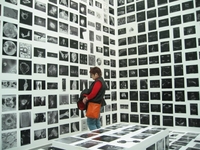I have been trying to track down more about the Ubisoft campus and development studio. Here is a story, Ubisoft, Canadian govt to create “university” from Gamespot. Here is the Ubisoft announcement, Ubisoft – UBISOFT ANNONCE LA CR…ATION D’UN STUDIO DE D…VELOPPEMENT ¿ QU…BEC.
It’s interesting that this news appears on the French version of the site, but not the English!
Continue reading Ubisoft Campus
University of Southern California
The Information Technology Program at The University of Southern California has a number of interesting minors in areas like Game Design and Management, and Game Programming.
Strangely this doesn’t seem to be the area that Electronic Arts donated to. See Game On, from the USC Public Relations about the $8 million gift to the School of Cinema-Television for the interactive media division.
LivePlasma

liveplasma is a search and visualization engine for music and movies that shows you related things in a colourful bubbly space. This is thanks to Steve Ramsay.
ARIA:
ARIA is an MIT Media Lab project from the Software Agents
that can do continuous retrieval and ranking of images based on typing. To me it suggests a more humble approach to agents than the “send off and forget” type of agent discussed in the 90s. This is more the “autocorrect” type of assistant. This is from Matt Patey.
Continue reading ARIA:
HyperJournal: an open journal system
HyperJournal is an open journal publishing system that supports XML (according to the docs) that is now in Alpha. It has an intruiging feature, “Dynamic Contextualization” that links things between articles including between articles at different Hyperjournal installations. I think that’s why they call it “HYPERjournal” as it is designed to automatically link things.
Continue reading HyperJournal: an open journal system
Online Journal
I am involved with a group of people developing an online journal for the humanities computing community. John W. sent me a link to Tools and Resources for Online Journal Editors and Publishers which looks like a great overview of the tools out there.
The question for us will be if we want to roll our own tools. Should the humanities computing community demonstrate the possibilities for technology or just concentrate on content?
Wooster Collective
The Wooster Collective: A Celebration of Street Art is a collective blog (“clog”) about street art that I got lost in. Thanks to Geoff T. for this.
Continue reading Wooster Collective
Who buys books in Canada?
The Globe and Mail has a story, Book buying up 23 per cent, report says by Rebecca Caldwell (Sat. April 2, 2005, R7) on a new report by Hill Strategies Research called, Who Buys Books in Canada (March 2005) which shows that spending on books rose 23% between 1997 and 2001. What is interesting is the size of the print culture business. Spending on books is about the same as movie tickets and newspapers. If you add magazines, newspapers, and books you see that print media dominates over other media.
Continue reading Who buys books in Canada?
Massive Change, the Show
 We went to the Bruce Mau show on Massive Change: The Future of Global Design at the Art Gallery of Ontario. After being disspointed in the web site (see Massive Change and Overrated Sight) I was more favorably impressed by the show. The first thing my wife noticed standing in line was how young the people coming were – it seems to have reached a demographic that doesn’t come to galleries. The show itself is didactic – there is lots of text to read and to listen to and most of it is earnest in an improving way. What is impressive is how they have taken what is essentially an essay and turned it into an exhibit that seemed to work for the 20-something crowd. The points are illustrated and exhibited in interesting ways like the room of images showing the ways we visualize our world.
We went to the Bruce Mau show on Massive Change: The Future of Global Design at the Art Gallery of Ontario. After being disspointed in the web site (see Massive Change and Overrated Sight) I was more favorably impressed by the show. The first thing my wife noticed standing in line was how young the people coming were – it seems to have reached a demographic that doesn’t come to galleries. The show itself is didactic – there is lots of text to read and to listen to and most of it is earnest in an improving way. What is impressive is how they have taken what is essentially an essay and turned it into an exhibit that seemed to work for the 20-something crowd. The points are illustrated and exhibited in interesting ways like the room of images showing the ways we visualize our world.
One side of me wished I could afford to turn a course into an exhibit like this. Imagine if you could exhibit a class and then assign the show as a field-trip alternative to the lecture. Hmmmm….
Another annoying feature of the show was that it treated everything as design. In many ways it was about politics and the environment. To think that design in anything other than the weak sense of creative solutions is the key is hubris. In a sense everthing human is designed, that is what we call intentional behavior aimed at a new outcome. In a stronger sense design is a subset of such practices and politicians are not designers.
Continue reading Massive Change, the Show
Old story on Silicon Knights
MacLeans has a story from June 11, 2001, titled “Gaming Knights; Canadian creator hope to score off Sony, Nintendo and Micrsoft” by Danylo Hawakeshka. It is on a game company, Silicon Knights, which is based in Saint Catherines, just down the road. Silicon Knights presents itself as organized around a “guild” philosophy which seems drawn from the gaming culture. This is from Kelly.
Continue reading Old story on Silicon Knights